History and exam
Key diagnostic factors
common
presence of risk factors
Key risk factors include age >60 years.
shoulder pain
The most common presenting complaint for rotator cuff impingement or rotator cuff tear is pain. Pain is typically worse at night and aggravated by overhead activities and commonly localises to the anterior lateral shoulder, near the deltoid insertion.
shoulder weakness
Common finding with rotator cuff tears, especially if associated with resisted external rotation (infraspinatus), abduction and elevation (supraspinatus), or isolated internal rotation (subscapularis).
loss of active range of motion
Highly suggestive of rotator cuff tear.
pain and weakness on external rotation test
With the arm at his or her side and the elbow flexed to 90°, the patient attempts to externally rotate against resistance supplied by the examiner. Tears extending to the infraspinatus result in pain and weakness.[Figure caption and citation for the preceding image starts]: External rotation testFrom the collection of Daniel J. Solomon, MD; used with permission [Citation ends].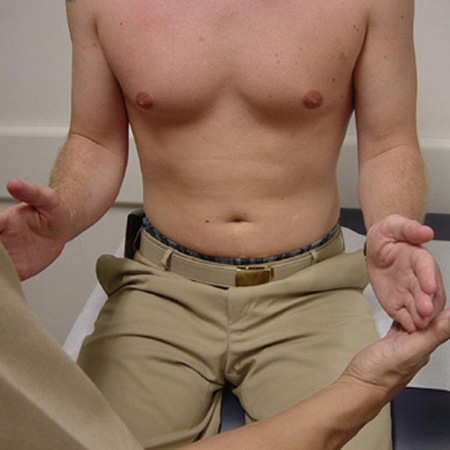
pain and weakness on empty-can test
The patient raises both arms slightly forward from the coronal plane of the trunk with thumbs pointing to the floor (as if emptying a can). The examiner applies pressure to the top of the arms, which the patient attempts to resist. Weakness indicates a supraspinatus tear.[Figure caption and citation for the preceding image starts]: Empty-can testFrom the collection of Daniel J. Solomon, MD; used with permission [Citation ends].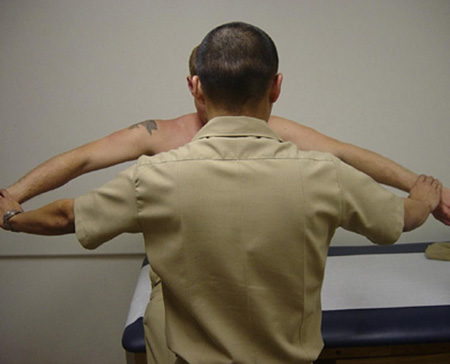
Other diagnostic factors
common
deltoid pain
The deltoid tuberosity is a common site of referred pain due to rotator cuff tendinopathy. This is thought to be caused by lateral bursal irritation or by deltoid fatigue.
night pain
Can occur as the patient rolls onto the inflamed, irritated shoulder. The presence of night pain is thought to be due to the venous congestion that occurs with recumbency and the increase in nocturnal prostaglandin secretion.[28]
pain and weakness on lift-off test
Evaluates the patient's ability to lift the hand away from the small of the back as the examiner applies resistance. The examiner must ensure that the patient uses the shoulder and arm rather than wrist and fingers to perform this task. Weakness suggests a subscapularis tear.[Figure caption and citation for the preceding image starts]: Lift-off testFrom the collection of Daniel J. Solomon, MD; used with permission [Citation ends].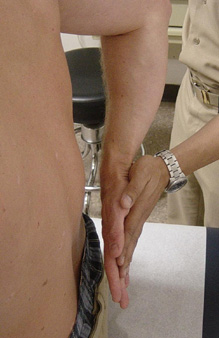
pain and weakness on belly-press test
The patient presses the hand against the umbilicus with the elbow forward from the trunk. The examiner applies resistance by placing his or her hand between the patient's hand and abdomen.[29] Inability to maintain elbow anterior to the coronal plane of the trunk suggests a subscapularis tear.
This test may be more appropriately performed supine, with the examiner securing the scapula to the examination table to ensure isolation of the subscapularis.[Figure caption and citation for the preceding image starts]: Belly-press testFrom the collection of Daniel J. Solomon, MD; used with permission [Citation ends].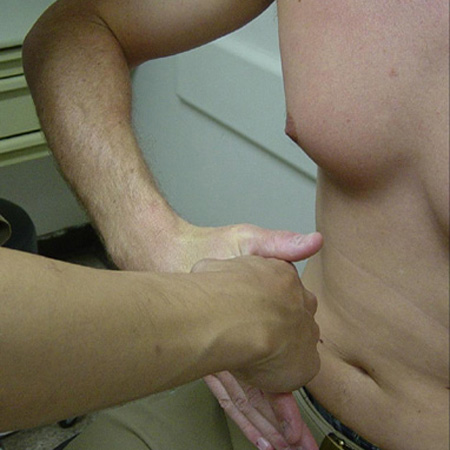
pain on Neer impingement test
The Neer impingement test can be performed with the patient seated or standing. The examiner keeps one hand on the patient's scapula to prevent rotation. As the patient's arm is elevated by the examiner, reproduction of pain is a positive test for impingement. [Figure caption and citation for the preceding image starts]: Neer impingement testFrom the collection of Daniel J. Solomon, MD; used with permission [Citation ends].
pain on Hawkins impingement test
The patient's arm is positioned at 90° of elevation and the elbow is bent to 90°. The examiner places an internal rotation force on the patient's arm. Reproduction of pain is a positive test for impingement.[Figure caption and citation for the preceding image starts]: Hawkins impingement testFrom the collection of Daniel J. Solomon, MD; used with permission [Citation ends].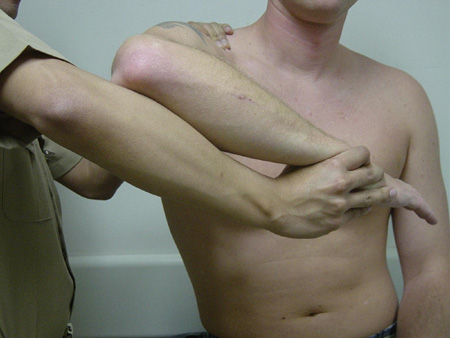
uncommon
adhesive capsulitis
Adhesive capsulitis ('frozen shoulder') is defined as the symmetrical loss of both passive and active motion due to soft-tissue contracture. Loss of passive shoulder motion may occur in the presence of large or massive rotator cuff tear. However, the adhesive capsulitis patient will demonstrate more capsular irritability - pain with extremes of motion, especially in external rotation. Stiffness can occur with massive chronic tears as a result of injury or failure to move the shoulder (prolonged immobilisation).
Risk factors
strong
age >60 years
Multiple studies have illustrated the direct correlation between incidence of tears and increasing age. Evidence suggests that the prevalence and the severity of rotator cuff tears increase with every decade of age, to the point where up to 50% of people over the age of 80 years have rotator cuff tears.[5][6][7][8][19]
One systematic review found that prevalence of rotator cuff abnormalities ranged from 9.7% in patients aged 20 years and younger to 62% in patients aged 80 years and older.[9]
weak
history of repetitive overhead movement
Repetitive overhead activity, especially in throwing sports, can have long-term effects on the avascular portion of the rotator cuff due to the excessive torsional and eccentric loads placed on the rotator cuff.[14]
history of superior labral tears
There is an increased association between undersurface and intratendinous rotator cuff tears and labral disorders, especially in superior labrum anterior posterior (SLAP) region.[16]
This is more common with repetitive overhead arm use, such as throwing and playing volleyball. This is likely due to increased eccentric loads, excessive torsional stress and internal impingement.
shoulder injury
Not all patients will present with an acute or subacute injury; the onset of symptoms in most cases is insidious.
Use of this content is subject to our disclaimer